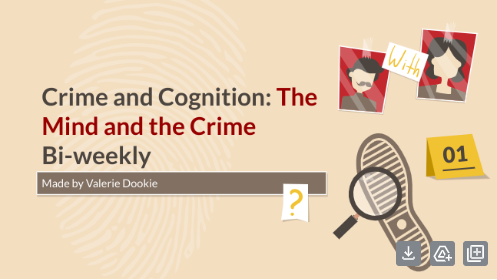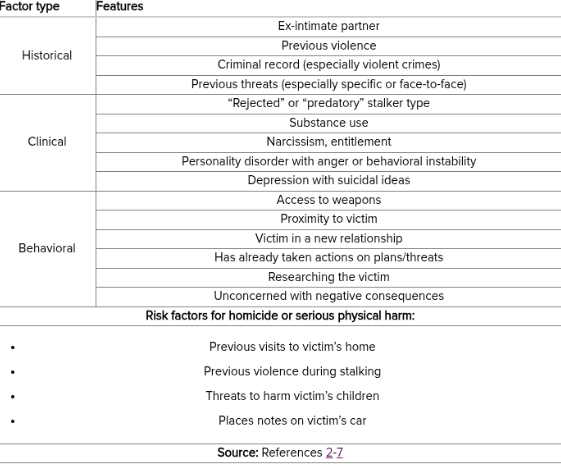
The Truth About Stalkers
Valerie Dookie
Many people think that stalking cases are black and white. A person becomes obsessed with someone else, follows them, keeps tabs on them, eventually gets bored, and goes away. However, this is not the case. There are actually multiple different types of stalkers, and each one has a different background, motive, and means of going about their stalking.
The first type is Rejected Stalkers. These kinds of stalkers are the most common and also happen to be the most dangerous. They are often the ones who pursue a victim after a romantic relationship with them has ended. Their motives are usually mixed with a desire for reconciliation, but also a drive for revenge. Another type of stalker, one that is typically portrayed in entertainment, is the Intimacy Seeking Stalker. These are the ones who believe that the stalkee is their “true love” and they are “meant to be together.” Many stalkers, especially ones of this classification, suffer from erotomania, which is the delusion in which someone believes another person is deeply in love with them. Intimacy-seeking stalkers will often brush off any legal repercussions, seeing them as prices to pay for their love. On the complete opposite side of this are the Incompetent Stalkers, who are aware that the victim is uninterested in them but still believe they can win them over with their bold actions. They also typically happen to be intellectually limited and socially incompetent, which is reflected in their actions and their struggles in social interactions. These stalkers will likely be the ones who do not directly approach the victim and watch them from afar. Resentful Stalkers are those whose motive is to scare the victim. They usually have some kind of vendetta against their target and feel like they have been persecuted by them in the past, and want to get some form of revenge. However, these stalkers are not always thinking logically when they feel this way because it is common for these types to suffer from mental illnesses such as paranoid personality or delusional disorders, ultimately affecting the way they act towards their victim. The fifth and final type of stalker is a Predatory Stalker. These stalkers are driven by violence, and their motive is often to sexually assault or attack their victim. Predatory Stalkers are classified as the most dangerous, as they are often a stranger to the victim and are very inconspicuous, ensuring the victim is unaware of the danger they are in until they’re attacked. These people use stalking as merely a preparation for their attack on the victim, which consists of thorough surveillance and learning all of the victim’s vulnerabilities.

James Knoll, MD; Phillip J. Resnick, MD. “Stalking intervention: Know the 5 stalker types, safety strategies for victims.” May 2007
One study showed that one out of every fourteen women is stalked at some point in their life, while one out of every fifty men is stalked throughout their life. It is much more common for women to get stalked than men. A separate study surveyed 8,000 women and 8,000 men, and the result showed that 640 out of the 8,000 women had been victims of stalking before, whereas 160 of the 8,000 men had been victims of stalking. During some stalking cases, the stalker does not stop until they murder their victim and possibly those close to the victim. Despite this fact, murder in stalking cases is only about 2% in the United States, but that does not mean the risk is not high. Stalkers are not always someone the victim doesn’t know; in fact, much of the time, the victim knows the stalker in some capacity. 90% of women who are killed by their ex-husbands had been previously stalked by him. Even with these high-risk situations, only about 50% of all stalking cases get reported to the police, and out of that 50%, only 25% lead to an arrest. Out of those who get arrested, hardly 12% result in criminal prosecution. In 88% of stalking cases that result in an arrest, the perpetrator goes free.
Stalking is a very serious and often overlooked threat that affects hundreds, if not thousands, of people each year. Not only is it common, but it is also dangerous and extremely underreported. Victims feel helpless and afraid, and more often than not, the legal system does not rule in their favor, falling short on providing the victim with protection or the stalker with consequences. Things are not the way they are in the movies; the bad guy does not always get caught, and the stalker is not always just someone who watches from afar. In reality, stalkers are some of the most complex and dangerous criminals out there, often hiding in plain sight. The public should aim to be better informed on this topic with the warning signs, different types of stalkers, and risks involved in order to protect themselves and others, increasing support for victims, and increasing legal protection to combat this issue.
Sources:















































